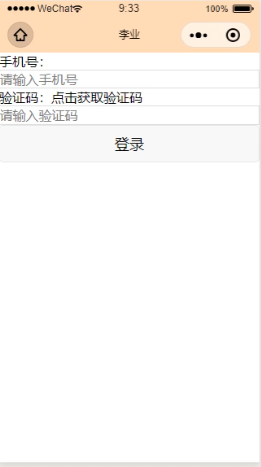day03 微信小程序
内容回顾
组件
- view
- text
- image
- textarea
- navigator
- button
事件
- bindtab
api(5个)
今日摘要
- 小程序
- 后端api
今日详细
1、数据绑定
- 基本绑定
- for循环
双向绑定
创建新目录
pages/telphone/telphone.wxml:(bindinput 前端输入自动触发后端bindPhone函数 实现数据的双向绑定)
<!--pages/telphone/telphone.wxml--> <view>手机号:</view> <input value="{{phone}}" bindinput="bindPhone" placeholder="请输入手机号"></input>
telphone.wxss:(给input框设置个颜色)
/* pages/telphone/telphone.wxss */
input{
border: 1rpx solid #ddd;
}
telphone.js:(和前端wxml的phone进行了数据绑定)
// pages/telphone/telphone.js Page({ /** * 页面的初始数据
数据双向绑定 */ data: { phone:"", },
bindPhone:function(e){
this.setData({ phone:e.detail.value});
},
小程序发送网络请求
pages/telphone/telphone.wxml:
<!--pages/telphone/telphone.wxml--> <view>手机号:</view> <input value="{{phone}}" bindinput="bindPhone" placeholder="请输入手机号"></input> <view>验证码: <view bindtap="messageCode">点击获取验证码 </view> </view> <input value="{{code}}" bindinput="bindCode" placeholder="请输入验证码"></input> <button bindtap="login">登录</button>

telphone.js:
// pages/telphone/telphone.js Page({ /** * 页面的初始数据 */ data: { phone:"", code:"" }, bindPhone:function(e){ this.setData({ phone:e.detail.value}); }, bindCode: function (e) { this.setData({ code: e.detail.value }); }, /** * 发送短信验证码 */ messageCode:function(){ // 手机长度限制 if (this.data.phone.length !=11){ // 弹窗 wx.showToast({ title: '手机号长度错误', icon:"none", // loading/success/none }) return; } // 正则匹配手机格式 var reg = /^(1[3|4|5|6|7|8|9])\d{9}$/; if(!reg.test(this.data.phone)){ wx.showToast({ title: '手机号格式错误', icon: "none", // loading/success/none }) return; } wx.request({ url: 'http://127.0.0.1:8000/api/message/', data: { phone: this.data.phone }, method: 'GET', success: function (res) { console.log(res); } }) }, /** * 用户登录 */ login:function(){ console.log(this.data.phone, this.data.code); // 将手机号和验证码发送到后端,后端进行登录。 wx.request({ url: 'http://127.0.0.1:8000/api/login/', data: { phone: this.data.phone, code: this.data.code}, method: 'POST', success: function(res) { console.log(res); } }) }, /** * 生命周期函数--监听页面加载 */ onLoad: function (options) { }, /** * 生命周期函数--监听页面初次渲染完成 */ onReady: function () { }, /** * 生命周期函数--监听页面显示 */ onShow: function () { }, /** * 生命周期函数--监听页面隐藏 */ onHide: function () { }, /** * 生命周期函数--监听页面卸载 */ onUnload: function () { }, /** * 页面相关事件处理函数--监听用户下拉动作 */ onPullDownRefresh: function () { }, /** * 页面上拉触底事件的处理函数 */ onReachBottom: function () { }, /** * 用户点击右上角分享 */ onShareAppMessage: function () { } })
在使用wx.request等有网络请求的API时需要遵循:
网络地址https
微信后台必须设置访问域名
本地测试:

2.2API
创建虚拟环境
在虚拟环境中安装
django==1.11.7
drf
创建项目
创建drf后端接口login和message:
urls.py:
from django.conf.urls import url,include from django.contrib import admin from api import views urlpatterns = [ url(r'^login/', views.LoginView.as_view()), url(r'^message/', views.MessageView.as_view()), ]
views.py:
from django.shortcuts import render from rest_framework.views import APIView from rest_framework.response import Response from rest_framework import serializers from rest_framework.exceptions import ValidationError import re def phone_validator(value): if not re.match(r"^(1[3|4|5|6|7|8|9])\d{9}$",value): raise ValidationError('手机格式错误') # 序列化 class MessageSerializer(serializers.Serializer): phone = serializers.CharField(label='手机号',validators=[phone_validator,]) class MessageView(APIView): def get(self,request,*args,**kwargs): """ 发送手机短信验证码 :param request: :param args: :param kwargs: :return: """ # 1.获取手机号 # 2.手机格式校验(序列化) ser = MessageSerializer(data=request.query_params) if not ser.is_valid(): return Response({'status':False,'message':'手机格式错误'}) phone = ser.validated_data.get('phone') # 3.生成随机验证码 import random random_code = random.randint(1000,9999) # 4.验证码发送到手机上,购买服务器进行发送短信:腾讯云 # TODO tencent.send_message(phone,random_code) """ 1.注册腾讯云,开通腾讯云短信。 2.创建应用 SDK AppID = 1400302209 3.申请签名(个人:公众号) ID 名称 260514 Python之路 4.申请模板 ID 名称 516680 miniprogram 5.申请腾讯云API https://console.cloud.tencent.com/cam/capi SecretId: SecretKey: 6.调用相关接口去发送短信 https://cloud.tencent.com/document/product/382/38778 SDK,写好的工具。 """ from tencentcloud.common import credential from tencentcloud.common.exception.tencent_cloud_sdk_exception import TencentCloudSDKException from tencentcloud.sms.v20190711 import sms_client, models from tencentcloud.common.profile.client_profile import ClientProfile from tencentcloud.common.profile.http_profile import HttpProfile try: cred = credential.Credential("secretId", "secretKey") client = sms_client.SmsClient(cred, "ap-guangzhou") req = models.SendSmsRequest() # 短信应用ID: 短信SdkAppid在 [短信控制台] 添加应用后生成的实际SdkAppid,示例如1400006666 req.SmsSdkAppid = "1400787878" # 短信签名内容: 使用 UTF-8 编码,必须填写已审核通过的签名,签名信息可登录 [短信控制台] 查看 req.Sign = "xxx" # 下发手机号码,采用 e.164 标准,+[国家或地区码][手机号] # 示例如:+8613711112222, 其中前面有一个+号 ,86为国家码,13711112222为手机号,最多不要超过200个手机号 req.PhoneNumberSet = ["+8613711112222"] # 模板 ID: 必须填写已审核通过的模板 ID。模板ID可登录 [短信控制台] 查看 req.TemplateID = "449739" # 模板参数: 若无模板参数,则设置为空 req.TemplateParamSet = ["666"] # 通过client对象调用DescribeInstances方法发起请求。注意请求方法名与请求对象是对应的。 # 返回的resp是一个DescribeInstancesResponse类的实例,与请求对象对应。 resp = client.SendSms(req) # 输出json格式的字符串回包 print(resp.to_json_string(indent=2)) except TencentCloudSDKException as err: print(err) # 5.把验证码+手机号保留(30s过期) """ # 5.1 搭建redis服务器(云redis) # 5.2 django中方便使用redis的模块 django-redis 配置: CACHES = { "default": { "BACKEND": "django_redis.cache.RedisCache", "LOCATION": "redis://127.0.0.1:6379", "OPTIONS": { "CLIENT_CLASS": "django_redis.client.DefaultClient", "CONNECTION_POOL_KWARGS": {"max_connections": 100} # "PASSWORD": "密码", } } } 使用: """ from django_redis import get_redis_connection conn = get_redis_connection() conn.set(phone,random_code,ex=30) return Response({"status": True,'message':'发送成功'}) class LoginView(APIView): def post(self,request,*args,**kwargs): print(request.data) return Response({"status":True})
settings.py:
... INSTALLED_APPS = [ 'django.contrib.admin', 'django.contrib.auth', 'django.contrib.contenttypes', 'django.contrib.sessions', 'django.contrib.messages', 'django.contrib.staticfiles', "rest_framework", ] ....




 浙公网安备 33010602011771号
浙公网安备 33010602011771号